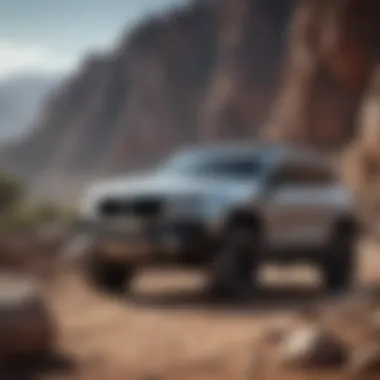Best SUVs for All Terrain: Performance and Design Insights


Intro
As the demand for SUVs has increased, so has the need for models that can truly conquer all terrains. Drivers are no longer satisfied with vehicles that are merely stylish or spacious. They want a vehicle that performs well both on highways and rugged off-road paths. This guide examines what differentiates the best SUVs for all-terrain driving. Key aspects such as performance capabilities, safety ratings, and design features are explored in depth. Additionally, the article focuses on what makes an SUV a versatile choice for various driving conditions.
Car Reviews
Overview of the Vehicle
The Toyota Land Cruiser stands out as a prime contender in the all-terrain SUV segment. Known for its robust design, this vehicle is engineered to withstand severe conditions. The Jeep Wrangler also receives attention, celebrated for its off-road prowess and modularity. Then there’s the Ford Bronco, which combines modern comfort with aggressive off-road features, appealing to adventure seekers.
Performance Analysis
When it comes to performance, Jeep Wrangler Rubicon leads in off-road capability. Equipped with powerful 3.6-liter V6 engine, it can easily navigate rocky trails. The Land Rover Defender is another excellent choice. Its Terrain Response System optimizes settings for varied landscapes, enhancing its adaptability. On the more urban-friendly side, the Subaru Outback offers an all-wheel-drive system designed for mixed terrains without sacrificing comfort.
Design and Interior Features
A good SUV for all-terrain driving must have robust design elements. For instance, the Toyota 4Runner comes with a durable frame and high ground clearance which make it effortlessly glide over obstacles. Inside, amenities vary from spacious seating arrangements to high-tech infotainment systems. Vehicles like the Mitsubishi Outlander provide extra tech features, enhancing overall driver comfort when pavement ends.
Safety Ratings and Specifications
Safety is non-negotiable for all-terrain vehicles. Models such as the Volvo XC90 emphasize safety technology, with multiple crash test accolades. The GMC Terrain offers advanced driver-assist features, providing added confidence for challenging terrains. Always pay attention to crash ratings and available driver assistance options; each element can influence choices profoundly.
Value for Money
Pricing for all-terrain SUVs varies significantly. Some entry-level models deliver good performance at a more reasonable cost. However, high-end offerings, like the Land Rover Discovery, prove their worth with unmatched luxury and performance. Thorough evaluation and comparison importantly aid potential buyers in measuring benefits against costs.
“Making educated decisions about which SUV to choose guarantees satisfaction down the road.”
Automotive Industry Trends
Emerging Technologies
The automotive sector is experiencing rapid innovation, entrenched notably in SUV designs. Advancements incorporate features like adjustable air suspension and eco-mode driving. Cutting-edge tech ensures enhanced maneuverability across diverse landscapes.
Changes in Consumer Preferences
Increasing consumer trends show a shift toward hybrid and electric SUVs. Environmentally conscious buyers look for vehicles that balance performance with sustainability.
Sustainability and Eco-Friendly Practices
Brands invest heavily in sustainability practices, focusing on reducing carbon footprints throughout production processes. For instance, BMW’s commitment to electric SUV models marries powerful performance with environmental responsibility.
Future of Electric Vehicles
Expect to see more electric SUVs coming soon. Vehicles such as the Rivian R1S and Ford Mustang Mach-E are hinting at a new way of off-roading, combining cutting-edge technology with rugged capabilities.
Industry Challenges and Solutions
Manufacturers face challenges from economic pressures and raw material shortages. However, embracing innovative practices or exploring alternative materials may serve to overcome some of these hurdles, positioning brands for future growth.
Buying Guides
How to Choose the Right Vehicle
Choosing an all-terrain SUV begins with identifying specific needs. Consider driving conditions: do you frequently traverse rocky trails, or do you need a vehicle with all-weather capabilities for city driving?
Financing and Insurance Tips
Crucial elements often overlooked include financing options and insurance policies. Transparency in interest rates and scales can help tremendously when assessing costs.
Common Mistakes to Avoid
Buyers might overlook essential features that can drastically affect performance. Hence, thorough research, understanding what features matter most, and test-driving vehicles are fundamental.
Maintenance and Ownership Considerations
Maintenance plans remain critical for prolonging the lifespan of your all-terrain vehicle. Options like Scion’s low-cost maintenance packages offer peace of mind, assisting in ownership decisions.
Resources for Further Research
For insightful automotive trends, engaging communities, or vehicle specifications, consider resources like Wikipedia, Reddit, or explore dynamic discussions on Facebook.


Preface
All-terrain vehicles have gained significant popularity due to their ability to traverse diverse landscapes. The right SUV can cater to both off-road adventures and daily commuting demands, making the selection of an appropriate model essential. This guide is crafted to illuminate SUVs that excel in various environments, allowing owners to feel confident in their vehicle choice.
Understanding All-Terrain Vehicles
All-terrain vehicles, or ATVs, are designed specifically for optimal performance across multiple terrains—ranging from rocky trails to muddy fields. There are critical considerations for potential buyers when identifying a suitable all-terrain SUV. First, consider what type of terrain you plan to conquer regularly. The nature of your adventures will directly influence the essential features such as suspension systems and wheel designs. For example, specialized drivetrains enable superior traction which, in rough conditions, makes a notable difference.
In additional to general vehicles which offer comfort and interior design, all-terrain SUVs must integrate performance-centric systems to manage harsher surfaces. Advanced technology also plays a role, such as electronic locking differentials, that physically adjusts tire performance. Recognizing these attributes is crucial, and it promotes informed consumer decisions which benefit the automotive marketplace as a whole.
The Importance of Versatility in SUVs
Versatility is a key trait in all-terrain vehicles as it signifies their capacity to perform in varied settings and meet different driver needs. The modern consumer likely uses their vehicle for a myriad of functions, so an all-terrain SUV should seamlessly transition from an outdoor expedition to a visit to the city.
Key elements such as interior space, tech integrations, and fuel efficiency are of interest. A vehicle's ability to handle suburban duties without sacrificing off-road capabilities ensures it remains a valuable asset throughout its lifespan. In contemporary automotive discussions, versatility emerges as both a significant consideration and a necessity, especially for families or individuals prioritizing practicality over sheer adventure capabilities.
“The measure of a true all-terrain vehicle is its balance between adventure readiness and daily use functionality.”
All this begs a study of specific features that characterize the best all-terrain SUVs on the market today.
Defining All-Terrain Capabilities
Understanding the capabilities of an all-terrain vehicle is paramount in choosing the right SUV. These capabilities allow the vehicle to perform in varying environments, making versatility a key factor for potential buyers. When you delve deeper into this aspect, you uncover essential features and benefits that contribute to overall all-terrain competence. This section examines important parameters that define all-terrain capabilities, ensuring that automotive enthusiasts make informed decisions.
Key Features of All-Terrain SUVs
Drivetrain Options
Drivetrain options significantly impact an SUV's ability to handle complex terrains. Four-wheel drive and all-wheel drive are crucial for maximizing traction, particularly during off-road excursions. The flexibility to switch between modes provides an advantage for drivers, particularly in dynamic conditions, like gravel roads or muddy paths.
One outstanding feature of drivetrain options is low-range gearing. This mechanism employs lower gear ratios, which optimally distributes power to the wheels. While this can greatly enhance off-road performance, it might sacrifice fuel efficiency on standard roads.
Suspension Systems
The suspension system plays a vital role in maintaining comfort and stability over uneven ground. A robust suspension allows the vehicle to absorb shocks from bumps and dips, thus enhancing overall performance. SUVs equipped with enhanced suspension systems, such as multi-link arrangements or air suspensions, offer better articulation; this contributes effectively to all-terrain maneuverability.
However, SUVs with upgraded suspension systems may increase repair costs over time. Knowing the potential expenses associated with these systems is beneficial when making a purchasing decision.
Tire Performance
Tire performance is a critical aspect often overlooked when assessing all-terrain prowess. The right tires can vastly improve grip, stability, and overall ride quality in challenging conditions. All-terrain tires generally feature aggressive tread patterns designed to provide traction on multiple surfaces.
A unique advantage of quality all-terrain tires is their increased durability against punctures and wear. However, these tires often produce more road noise and might affect fuel efficiency under normal driving conditions.
Assessing Terrain Types
Off-Road Conditions
Recognizing different off-road conditions assists buyers in identifying the best all-terrain SUVs for their needs. These conditions range from dusty trails to strenuous rocky paths. Importantly, ideal SUVs must pass performance tests tailored to face such challenges.
One critical feature in these scenarios is the approach and departure angles. Superior angles enable SUVs to navigate uneven obstacles without damaging the vehicle, a key detail often prioritized by enthusiasts.
Rocky Terrain
Driving on rocky terrain presents unique challenges, especially for suspension articulation and stability. Vehicles that shine in this environment possess advanced differential systems, allowing for better traction when wheels encounter diverse surfaces. These advanced systems enable the vehicle to navigate tight turns and inclines effortlessly.
With rocky paths, torque vectoring, which transfers power to specific wheels, also becomes invaluable. However, using these advanced features can also escalate the cost of both initial purchase and potential repairs.
Snow and Mud
Severe weather conditions, such as snow and mud, demand equal consideration. Understanding features such as tread design and electronic controls enhance performance around slippery surfaces. Each SUV may come equipped with settings tailored for high traction in these instances.
Snow drive modes can automatically fine-tune algorithms in the SUV to reduce wheel spin. At the same time, mud features improve the vehicle's capacity to push through softer terrains without losing momentum. Buyers must weigh the benefits against the realistic frequency of such conditions in their driving lives.
Excellent off-road capability directly correlates to enhanced driver experience and increased safety.
Understanding and placing the right importance on these elements shapes crucial considerations during the purchasing process for an all-terrain SUV.
Factors Influencing All-Terrain Performance
The performance of an SUV in various terrains depends on multiple factors. Understanding these factors helps buyers make an informed decision. When thinking about driving through rocky paths, forest trails, or muddy roads, make sure you check specific details of performance. The interplay of specific features sets apart all-terrain SUVs from standard vehicles.


Performance Metrics
Power and Torque
Power and torque are key attributes that influence an SUV's ability to navigate challenging terrains.
Power represents how much energy the engine can produce, while torque reflects the movement force generated by the vehicle. For all-terrain driving, both must be present in optimal amounts.
A powerful engine ensures that the vehicle can overcome obstacles, like steep inclines or difficult mud. Higher torque typically means that the SUV can maneuver precisely at slower speeds, which is crucial in rough surroundings. The benefit of having good power and torque is this combination of energy and control. Most off-road enthusiasts look for vehicles with robust specifications, leading to better overall capability in harsh terrains.
That being said, finding a balance is also vital. Excessive power without adequate handling can create safety issues during off-road adventures. Thus, evaluating how power and torque influence driving experience is important.
Handling and Stability
Handling and stability affect how well an SUV responds to road conditions. It refers to the vehicle's ability to maintain control and composure on uneven surfaces, which is tea significant aspect while taking sharp turns or going downhill.
Good handling improves responsiveness, and this allows the driver to make quick adjustments according to the road type. Reliable Stability enhances safety and adds confidence while driving through difficult terrains. SUV enthusiasts often opt for vehicles noted for consistent handling characteristics. Additionally, features such as electronic stabilisation contribute to superior driving experience, assisting in rough patches.
Ultimately, how a vehicle handles in various climatic and underfoot conditions determines if it is suitable for all-terrain use. Ignoring understanding what impacts handling could lead to misjudgments in vehicle choice.
Safety Features
Traction Control
Traction control plays an important role in preventing wheel spin on loose surfaces. It allows for better rotation when the vehicle is in uncertain terrains. For drivers, this means a reduction in the possibility of getting stuck in mud or snow.
Its major characteristics make it a valuable feature for any all-terrain SUV. Advanced traction systems continuously assess vehicle grip. For takeaway, when driving on slippery or uneven ground, effective traction control improves safety and maintains momentum.
However, depending solely on technology can sideline crucial driver experience. Knowing how to read terrain and use traction appropriately also matters
Advanced Safety Systems
Advanced safety systems have evolved to offer drivers peace of mind when navigating through challenging terrains. Systems such as lane-keeping assist and collision warning drive more attention to road conditions that can be overlooked by drivers. These features function to assist drivers but do not replace completely safe driving practices.
Notable qualities within these systems increase driver awareness. They work to understand the environment outside and reduce risk. Including integrated technologies reduce accidents and enhance functionalities. Employing preventive measures ensures a safer journey through rugged landscapes but, over-reliance shouldn't become a standard approach.
In culmination, understanding the different elements influencing performance is essential when looking for all-terrain SUVs. The details discussed reflect predictions of performance, alongside the assurance of safety. Be it power outputs or reliable traction, they embody what makes an SUV stand tall in an all-terrain context.
Top SUVs for All Terrain
Top SUVs for all terrain play a crucial role in this guide. They offer drivers the ability to traverse multiple environments, making them a sought-after choice for off-roading and adventure enthusiasts. It is not only about performance metrics but also about ensuring reliability, comfort, and safety.
Understanding different models will help prospective buyers navigate their choices more effectively. This section serves as a focal point, providing insights into both established and emerging players in the SUV market.
Model Comparisons
Jeep Wrangler
The Jeep Wrangler stands out due to its time-tested off-road capabilities. Its robust build and distinct design are indicative of its heritage. It is a market leader for enthusiasts who seek uncommon terrains.
A key characteristic of the Wrangler is its exceptional articulation. This feature allows for improved traction on uneven surfaces. The removable body panels empower users to enhance customization, which certainly contributes to its popularity.
However, one disadvantage is its relatively firm ride on regular roads. It could feel less refined compared to more commuter-friendly SUVs.
Toyota 4Runner
The Toyota 4Runner is a staple option among off-roaders. Its unibody chassis contributes to remarkable durability. This SUV is built for those needing real off-road performance without compromising daily usability. The strength of this model lies in the available four-wheel-drive system.
What sets the 4Runner apart is its spacious interior. Users appreciate the ample cargo space for gear and equipment. Nonetheless, the downside of its powerful capabilities is lower fuel efficiency, which may not be ideal for all drivers.
Land Rover Defender
The Land Rover Defender carries a legacy that showcases both luxury and capability. It caters to drivers who prioritize premium comfort on top of off-road performance. As the new model incorporates modern technology, it stands out for its easy navigation even in tough conditions.
The unique feature of the Defender is its all-terrain progress control. This system assists drivers in mastering challenging landscapes with ease. However, it is worth acknowledging that it comes with a higher price tag, resulting in potential barriers for budget conscious buyers.
Emerging Options
Ford Bronco
Ford Bronco signifies an exciting return to the off-road SUV market. Its distinctive design attracts buyers looking for an authentic adventure vehicle. A standout feature is its off-road modes, which include G.O.A.T. (Go Over Any Terrain).


The Bronco’s modular options allow for extensive customization. Drivers can fine-tuneing to suit their journey, making it a versatile choice. Still, it is a new market player so some buyers may want geographically diverse consumer opinions to validate their interest.
Subaru Outback
Though often thought of as a wagon, the Subaru Outback performs admirably off the beaten path. This model ensures it can handle light to moderate off-road conditions and is known for its symmetrical all-wheel drive technology. Thus, it's a practical choice for those seeking versatility.
A great advantage is its impressive safety ratings. The Outback shines in reliability, capturing the attention of conscientious consumers. However, it's not as rugged as traditional SUVs, which may limit its overall appeal for serious off-roaders.
Mitsubishi Outlander
Mitsubishi Outlander offers a blend of practicality and all-terrain capacity. Valued for its family-friendly design, it’s a prime candidate for those who require space without sacrificing capability. One notable feature is its all-wheel control system, providing steady handling as environments change.
Despite its competitiveness, Outlander lacks certain advanced off-road features found in higher-end rivals. A fully loaded trim may elevate the option but still leaves some uncertainty regarding raw terrain handling.
When selecting an all-terrain SUV, consider the trade-offs carefully among practicality, performance, and comfort.
Consumer Considerations
When exploring SUVs designed for all-terrain, consumer considerations are crucial. Buyers must wisely assess finansial outlays, long-term expenses, and the true cost of ownership. This information directly impacts the decision-making process, ultimately guiding consumers toward the best choice matched to their needs and resources.
Budgeting for an All-Terrain SUV
The first reality check involves budgeting for an all-terrain SUV. Models vary widely in price. Consequently, readers should evaluate how much willing to spend. A solid starting point is calculating not just the initial purchase price but also possible future costs, particularly concerning upkeep and repairs.
Here are some factors to consider during budgeting:
- Initial costs: Research vehicle prices and available trims.
- Financing options: Understand various financing alternatives or incentives offered by different manufacturers.
- Trade-in values: Assess the worth of a current vehicle, if applicable, which may offset the new purchase.
Prioritizing an accurate budget and having a clear vision can help consumers in avoiding overwhelming financial responsibilities in life after acquiring the vehicle.
Ownership Costs and Maintenance
Owning an all-terrain SUV comes with its share of costs beyond mur payments. Consumers must consider both driving habit and conditions. Different manufacturers offer varying plans, therefore shoppers should return to their initial research.
Fuel Efficiency
Fuel efficiency is a critical aspect for many SUV buyers. It reflects directly on how sustainable a vehicle is, monetarily and environmentally. Efficient fuel usage can trim recurring filling expenses and play a role in reducing a driver’s carbon footprint. There's substantial variation when considering off-road SUVs. Some stability safely maintain fuel economy in diverse terrain conditions. However, keep in mind that rugged capability may often come with a trade-off in fuel efficiency.
Key points for fuel efficiency consideration include:
- Engine Type: Specific engine configurations like turbocharged four-cylinder might save gas but adjust performance off-road.
- Weight# Impacts on fuel usage often depend on vehicle weight and drivng tech utilized.
Repair and Maintenance Insights
Repairs and maintenance practices may offer valuable insight into ownership decisions. Maintaining an all-terrain SUV typically means ensuring the vehicle's longevity in harsh, unpredictable environments. Service intervals, nature of repairs, and needed parts can greatly affect long-term expenses.
Many reputable brands provide comprehensive warranties, which support buyers during initial years. Receiving good coverage benefits those venturing into rugged country. Understanding how a vehicle is constructed, specifically regarding critical components like suspension and drivetrain, yields insight into useful maintenance in the future.
Consider these elements when evaluating repair and maintenance:
- Regularity of Service: Certain makes require frequent maintenance intervals.
- Parts Accessibility: Seek models that offer parts easily found, ensuring economical fixes when necessary.
Ending
In the ever-evolving landscape of SUVs, the conclusion drawn regarding all-terrain capabilities encompasses the essence of performance, adventure, and safety. The significance of this topic is unparalleled, particularly for individuals who seek reliability in diverse conditions. Given an increasing number of people venturing beyond standard road networks, understanding the attributes of all-terrain SUVs becomes paramount.
The careful consideration of elements such as drivetrain options, suspension systems, and tire effectiveness directly affects an SUV's performance on varied terrains. These factors not only enhance the driving experience but also ensure safer journeys, even in unexpected situations. Therefore, recognizing their importance underscores that the same vehicle needs to adapt efficiently to different environmental challenges without compromising comfort.
In addition to performance metrics, it becomes essential to address ownership concerns. Owning an all-terrain capable SUV involves making thought-out budgetary plans along with being aware of long-term operational costs. This creates the full circle of responsibilities and benefits associated with owning such specialized vehicles. When buyers comprehend both immediate physical characteristics and broader finance matters, along with the advancements in automotive technology, they empower themselves to make informed decisions.
By combining the multifaceted aspects of what constitutes the best all-terrain SUV, along with the vision of where future technology might lead us, the entire discussion serves not just to enlighten prospective buyers, but also to inspire engagement and investment in a field that is rapidly evolving.
Final Thoughts on All-Terrain SUVs
In wrapping up, all-terrain SUVs afford users various benefits, particularly adaptability in multiple settings. This type of vehicle stands significant for many, catering to those seeking adventure, family transportation, or fulfilling professional responsibilities through varied terrains. For novices, learning about the distinctive features creating high capabilities will inspire confidence in their choices.
Equipping oneself with knowledge will drive one towards making decisions profoundly beneficial in aligning performance needs with personal lifestyles. Understanding that no two models for all terrain are identical encourages unique consumer choices frankly answering specific obstacle needs. Evaluating attributes properly leads to empowered ownership.
The Future of All-Terrain Technology
Looking forward, the future strategies of all-terrain vehicles seem promising. As regulations evolve for fuel efficiency and emissions, simultaneously seeking capability isn't merely preferred but crucial. Manufacturers increasingly turn to hybrid technologies and electric vehicle styles stationed to confront ysteria of fiercer environmental criteria.
The notion of artificial intelligence and autonomous features will also likely flip conventional constraints on their heads. Enhanced traction control as well as confirmed navigation through rugged copies depend on integration of technology aiming for sociable usability sparked as optional settings. Future designs may bring about multi-terrain-assisted navigation, scannng and responding to possibilities quicker than a human ever could.
Clearly signaliga the neXt traits model development may impose curb unpredictability. Embracing technological transitions while considering diverse conditions intake will only accelerate capability rush face forward. This prospective variety adds flair to the upcoming landscape where safety, versatility, and shared enhancements could converge.
This engagement shows just how essential it continuesIn molding strong connections between enthusiasts, brands and communities on which innovative horizons shall shatter boundaries unwittingly forming newer driving landscapes across the globe.







